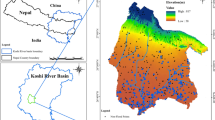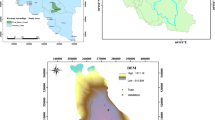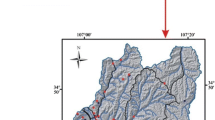Abstract
Identifying flood prone areas is essential for basin management. In this paper, a spatial prediction technology of flood susceptibility based on multiple kernel learning (MKL) is proposed. We establish the flood susceptibility model by using EasyMKL, nonlinear MKL (NLMKL), Representative MKL(RMKL), Generalized MKL(GMKL), support vector machine(SVM) with linear kernel and SVM with Gaussian radial base function(RBF) kernel, The spatial prediction of flood susceptibility in Sanhuajian basin of the Yellow River is carried out. We use MODIS remote sensing images to obtain historical flood inundation sites in the study area. Then, ten flood conditioning factors are used as inputs to the flood susceptibility model. The model performance is evaluated in terms of accuracy (ACC), balanced F Score (F1 score), and areas under the curve (AUC). According to the results, MKL significantly outperforms the SVM adopting single kernel, and NLMKL(ACC=0.833,F1=0.841,AUC=0.889) demonstrates the best comprehensive performance. The flood susceptibility map generated by MODIS remote sensing images and MKL, therefore, can provide effective help for researchers and decision makers in flood management.








Similar content being viewed by others
References
Aiolli F, Donini M (2015) EasyMKL: a scalable multiple kernel learning algorithm. Neurocomputing 169:215–224. https://doi.org/10.1016/j.neucom.2014.11.078
Arratia A, Belanche LA, Fábregues L (2020) An evaluation of equity premium prediction using multiple kernel learning with financial features. Neural Process Lett 52(1):117–134. https://doi.org/10.1007/s11063-018-09971-7
Barnes WL, Pagano TS, Salomonson VV (1998) Prelaunch characteristics of the moderate resolution imaging spectroradiometer (modis) on eos-am1. IEEE Trans Geosci Remote Sens 36(4):1088–1100. https://doi.org/10.1109/36.700993
Beilicci E, Beilicci R, Visescu M (2016) Study of flooding risk areas using 1D/2D advanced hydroinformatic tools. Int Multidiscip Sci GeoConf SGEM
Chapi K, Singh VP, Shirzadi A, Shahabi H, Bui DT, Pham BT, Khosravi K (2017) A novel hybrid artificial intelligence approach for flood susceptibility assessment. Modell Softw 95:229–245. https://doi.org/10.1016/j.envsoft.2017.06.012
Chen B, Shi F, Lin T, Shi P, Zheng J (2020) Intensive Versus Extensive Events? Insights from Cumulative Flood-Induced Mortality Over the Globe, 1976–2016. Int J Disaster Risk Sci 11:441–451. https://doi.org/10.1007/s13753-020-00288-5
Chen Y, Huang C, Ticehurst C, Merrin L, Thew P (2013) An evaluation of MODIS daily and 8-day composite products for floodplain and wetland inundation mapping. Wetlands 33(5):823–835. https://doi.org/10.1007/s13157-013-0439-4
Choubin B, Moradi E, Golshan M, Adamowski J, Sajedi-Hosseini F, Mosavi A (2019) An ensemble prediction of flood susceptibility using multivariate discriminant analysis, classification and regression trees, and support vector machines. Sci Total Environ 651:2087–2096. https://doi.org/10.1016/j.scitotenv.2018.10.064
Coltin B, McMichael S, Smith T et al (2016) Automatic boosted flood mapping from satellite data. Int J Remote Sens 37(5):993–1015. https://doi.org/10.1080/01431161.2016.1145366
Cortes C, Mohri M, Rostamizadeh A (2009) Learning non-linear combinations of kernels. Adv Neural Inf Process Syst 396–404
Damasevicius R (2010) Optimization of SVM parameters for recognition of regulatory DNA sequences. Top 18(2):339–353. https://doi.org/10.1007/s11750-010-0152-x
Dodangeh E, Choubin B, Eigdir AN, Nabipour N, Panahi M, Shamshirband S, Mosavi A (2020) Integrated machine learning methods with resampling algorithms for flood susceptibility prediction. Sci Total Environ 705:135983. https://doi.org/10.1016/j.scitotenv.2019.135983
Do H, Kalousis A, Woznica A, Hilario M (2009) Margin and radius based multiple kernel learning. Machine Learning and Knowledge Discovery in Databases, Springer, Berlin, Heidelberg, pp 330–343
Gao BC (1995) NDWI – A normalized difference water index for remote sensing of vegetation liquid water from space. Remote Sens Environ 58:257–266. https://doi.org/10.1117/12.210877
Gallant JC, Dowling TI (2003) A multiresolution index of valley bottom flatness for mapping depositional areas. Water Resour Res 39(12):1347–1359. https://doi.org/10.1029/2002WR001426
Gönen M, Alpaydin E (2011) Multiple kernel learning algorithms. J Mach Learn Res 12:2211–2268. https://doi.org/10.5555/1953048.2021071
Gu Y, Liu T, Jia X, Benediktsson JA, Chanussot J (2016) Nonlinear multiple kernel learning with multiple-structure-element extended morphological profiles for hyperspectral image classification. IEEE Trans Geosci Remote Sens 54(6):3235–3247. https://doi.org/10.1109/TGRS.2015.2514161
Hoch JM, van Beek R, Winsemius HC, Bierkens MFP (2018) Benchmarking flexible meshes and regular grids for large-scale fluvial inundation modelling. Adv Water Resour 121:350–360. https://doi.org/10.1016/j.advwatres.2018.09.003
Huang C, Chen Y, Wu J (2014) Mapping spatio-temporal flood inundation dynamics at large river basin scale using time-series flow data and MODIS imagery. Int J Appl Earth Obs Geoinf 26:350–362. https://doi.org/10.1016/j.jag.2013.09.002
Hu H, Li Q, Zhao Y, Zhang Y (2021) Parallel deep learning algorithms with hybrid attention mechanism for image segmentation of lung tumors. IEEE Trans Ind Inform 17(4):2880–2889. https://doi.org/10.1109/TII.2020.3022912
Janizadeh S, Vafakhah M, Kapelan Z et al (2021) Novel bayesian additive regression tree methodology for flood susceptibility modeling. Water Resour Manag. https://doi.org/10.1007/s11269-021-02972-7
Kia MB, Pirasteh S, Pradhan B et al (2012) An artificial neural network model for flood simulation using GIS: Johor River Basin, Malaysia. Environ Earth Sci 67(1):251–264. https://doi.org/10.1007/s12665-011-1504-z
Liuzzo L, Sammartano V, Freni G (2019) Comparison between different distributed methods for flood susceptibility mapping. Water Resour Manag 33:3155–3173. https://doi.org/10.1007/s11269-019-02293-w
Mateo CMR, Yamazaki D, Kim H, Champathong A, Vaze J, Oki T (2017) Impacts of spatial resolution and representation of flow connectivity on large-scale simulation of floods. Hydrol Earth Syst Sci 21:5143–5163. https://doi.org/10.5194/hess-21-5143-2017
Pappenberger F, Beven K, Horritt M, Blazkova S (2005) Uncertainty in the calibration of effective roughness parameters in HEC-RAS using inundation and downstream level observations. J Hydrol 302(1–4):46–69. https://doi.org/10.1016/j.jhydrol.2004.06.036
Pradhan B, Lee S (2010) Landslide susceptibility assessment and factor effect analysis: backpropagation artificial neural networks and their comparison with frequency ratio and bivariate logistic regression modelling. Modell Softw 25(6):747–759. https://doi.org/10.1016/j.envsoft.2009.10.016
Qi R, Wu J, Guo F, Xu L, Zou Q (2020) A spectral clustering with self-weighted multiple kernel learning method for single-cell RNA-seq data. Brief Bioinform 22(24):bbaa216. https://doi.org/10.1093/bib/bbaa216
Rajib A, Liu Z, Merwade V, Tavakoly A, Follum M (2020) Towards a large-scale locally relevant flood inundation modeling framework using SWAT and LISFLOOD-FP. J Hydrol 581:124406. https://doi.org/10.1016/j.jhydrol.2019.124406
Regmi NR, Giardino JR, Vitek JD (2010) Modeling susceptibility to landslides using the weight of evidence approach: Western Colorado, USA. Geomorphology 115(1–2):172–187. https://doi.org/10.1016/j.geomorph.2009.10.002
Saleh A, Abdel-Nasser M, Angel GM et al (2018) Aggregating the temporal coherent descriptors in videos using multiple learning kernel for action recognition. Pattern Recogn Lett 105:4–12. https://doi.org/10.1016/j.patrec.2017.06.010
Shafapour TM, Kumar L, Neamah JM, Shabani F (2019) Evaluating the application of the statistical index method in flood susceptibility mapping and its comparison with frequency ratio and logistic regression methods. Geomatics Nat Hazards Risk 10(1):79–101. https://doi.org/10.1080/19475705.2018.1506509
Smith MJ, Goodchild MF, Longley PA (2007) Geospatial analysis: a comprehensive guide to principles, techniques and software tools (2. Ed.). DBLP
Tehrany MS, Pradhan B, Jebur MN (2013) Spatial prediction of flood susceptible areas using rule based decision tree (DT) and a novel ensemble bivariate and multivariate statistical models in GIS. J Hydrol 504:69–79. https://doi.org/10.1016/j.jhydrol.2013.09.034
Tehrany MS, Pradhan B, Jebur MN (2014) Flood susceptibility mapping using a novel ensemble weights-of-evidence and support vector machine models in GIS. J Hydrol 512:332–343. https://doi.org/10.1016/j.jhydrol.2014.03.008
Teng J, Jakeman AJ, Vaze J, Croke BFW, Dutta D, Kim S (2017) Flood inundation modelling: A review of methods, recent advances and uncertainty analysis. Environ Modell Softw 90:201–216. https://doi.org/10.1016/j.envsoft.2017.01.006
Tien BD, Hoang N, Martínez-álvarez F, Ngo PT, Hoa PV, Pham TD, Samui P, Costache R (2020) A novel deep learning neural network approach for predicting flash flood susceptibility: A case study at a high frequency tropical storm area. Sci Total Environ 701:134413. https://doi.org/10.1016/j.scitotenv.2019.134413
Tien BD, Tuan TA, Klempe H, Pradhan B, Revhaug I (2016) Spatial prediction models for shallow landslide hazards: a comparative assessment of the efficacy of support vector machines, artificial neural networks, kernel logistic regression, and logistic model tree. Landslides 13(2):361–378. https://doi.org/10.1007/s10346-015-0557-6
Townshend JRG, Justice CO (1986) Analysis of the dynamics of African vegetation using the normalized difference vegetation index. Int J Remote Sens 7:1435–1445. https://doi.org/10.1080/01431168608948946
Varma M, Babu B (2009) More generality in efficient multiple kernel learning. Int Conf Mach Learn ACM 1065–1072
Wang Z, Zheng S (2014) Application of the meteorological and hydrological models coupling in the flood forecasting in Sanmenxia-Huayuankou reach of the Yellow River. Meteorol Environ Sci 37(02):8–13 (In Chinese). https://doi.org/10.16765/j.cnki.1673-7148.2014.02.016
Yariyan P, Janizadeh S, Van Phong T, Nguyen HD, Costache R, Van Le H, Pham BT, Pradhan B, Tiefenbacher JP (2020) Improvement of best first decision trees using bagging and dagging ensembles for flood probability mapping. Water Resour Manag 34(9):3037–3053. https://doi.org/10.1007/s11269-020-02603-7
Zhao G, Pang B, Xu Z, Peng D, Xu L (2019) Assessment of urban flood susceptibility using semi-supervised machine learning model. Sci Total Environ 659:940–949. https://doi.org/10.1016/j.scitotenv.2018.12.217
Funding
This work was supported by National Key Research and Development Program of China (Grant No: 2018YFC0407904).
Author information
Authors and Affiliations
Contributions
Q. Hu: Conceptualization, Formal analysis, Investigation, Methodology, Software, Validation, Roles/Writing - original draft. Y.L. Zhu: Funding acquisition, Project administration, Writing - review & editing. H.X. Hu: Conceptualization, Methodology, Supervision, Writing - review & editing. Z. Guan: Data curation, Software, Visualization. Z.Y. Qian: Data curation, Software, Visualization. A. Yang: Resources, Project administration.
Corresponding author
Ethics declarations
Ethical Approval
All authors have seen and agreed with the contents of the manuscript and are looking forward to publishing this paper on “Water Resources Management” journal.
Consent to Participate
Not applicable.
Consent to Publish
Not applicable.
Conflict of Interest
The authors declare that there is no conflict of interest.
Competing Interests
The authors declare no competing interests.
Additional information
Publisher's Note
Springer Nature remains neutral with regard to jurisdictional claims in published maps and institutional affiliations.
Appendices
Rights and permissions
About this article
Cite this article
Hu, Q., Zhu, Y., Hu, H. et al. Multiple Kernel Learning with Maximum Inundation Extent from MODIS Imagery for Spatial Prediction of Flood Susceptibility. Water Resour Manage 36, 55–73 (2022). https://doi.org/10.1007/s11269-021-03010-2
Received:
Accepted:
Published:
Issue Date:
DOI: https://doi.org/10.1007/s11269-021-03010-2





